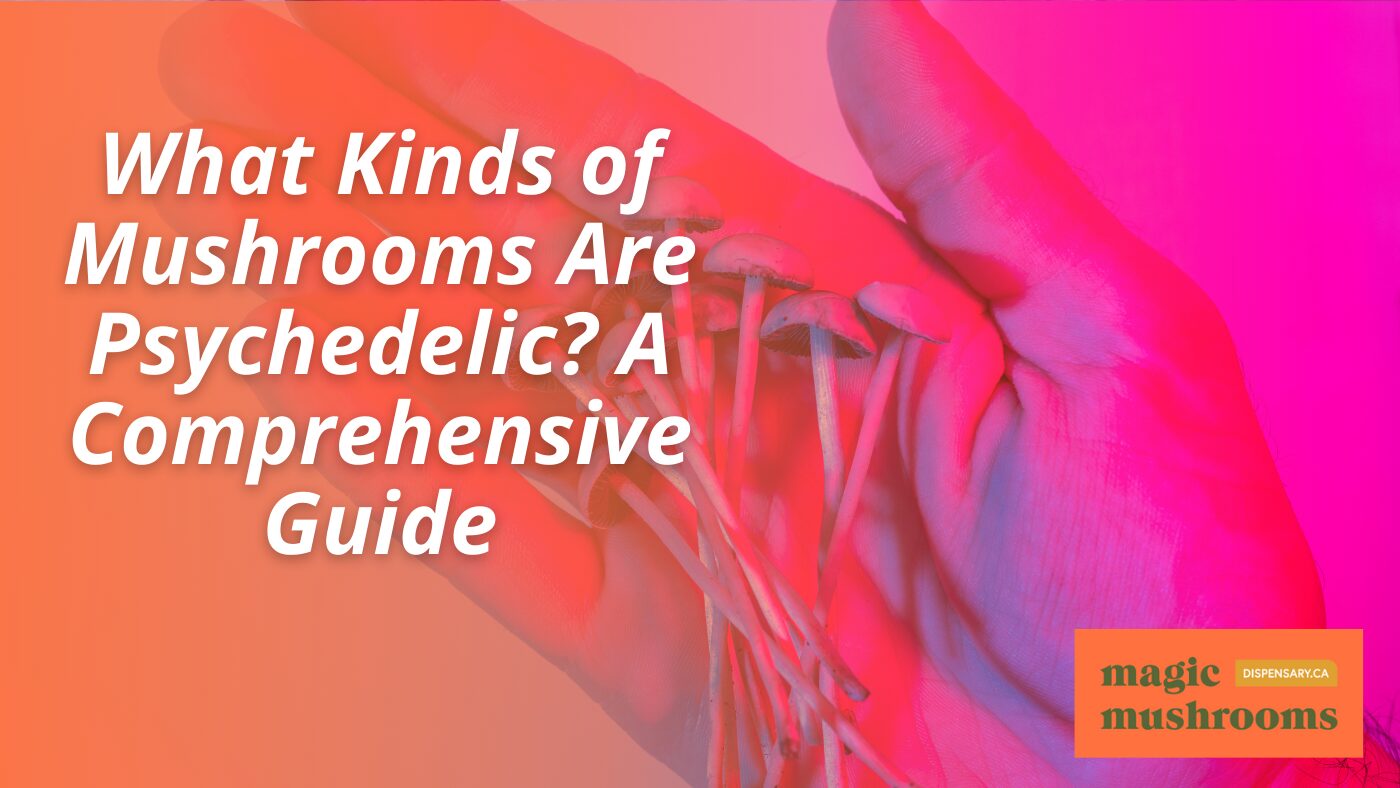Commonly referred to as ‘magic’ mushrooms, psychedelic mushrooms fall under the psychedelic species of mushrooms, with the majority being from the Psilocybe, Panaeolus, and Gymnopilus genera. These mushrooms are rich in psychoactive substances, chiefly psilocybin and psilocin, known for their capacity to produce profound alterations in consciousness. Varieties like Psilocybe Cubensis, Psilocybe Semilanceata, and Gymnopilus Purpuratus stand out for their distinct psychedelic effects. Each type within this group of psychedelic mushrooms has its own unique requirements for growth, visual characteristics, and levels of psychedelic intensity. They have been utilized throughout history and into modern times across various cultures for spiritual, cultural, and potential therapeutic purposes. For a comprehensive examination of their wide-ranging qualities, beneficial effects, and advice on safe use, our detailed guide is a crucial tool.
Key Takeaways
- Psychedelic mushrooms contain psychoactive compounds like psilocybin and psilocin, found in Psilocybe, Panaeolus, and Gymnopilus species.
- Psilocybe Cubensis, Semilanceata, Cyanescens, Azurescens, Mexicana, Tampanensis, and Atlantis are among the potent psychedelic species.
- Gymnopilus Purpuratus, Copelandia Cyanescens, and Panaeolus Cinctulus are other recognized psychedelic mushrooms with varying potencies.
- The psychoactive effects of these mushrooms vary based on their psilocybin content, individual mindset, and environment.
- Psychedelic mushrooms have potential therapeutic benefits for treating mental health conditions like anxiety and depression.
What Kinds of Mushrooms Are Psychedelic?
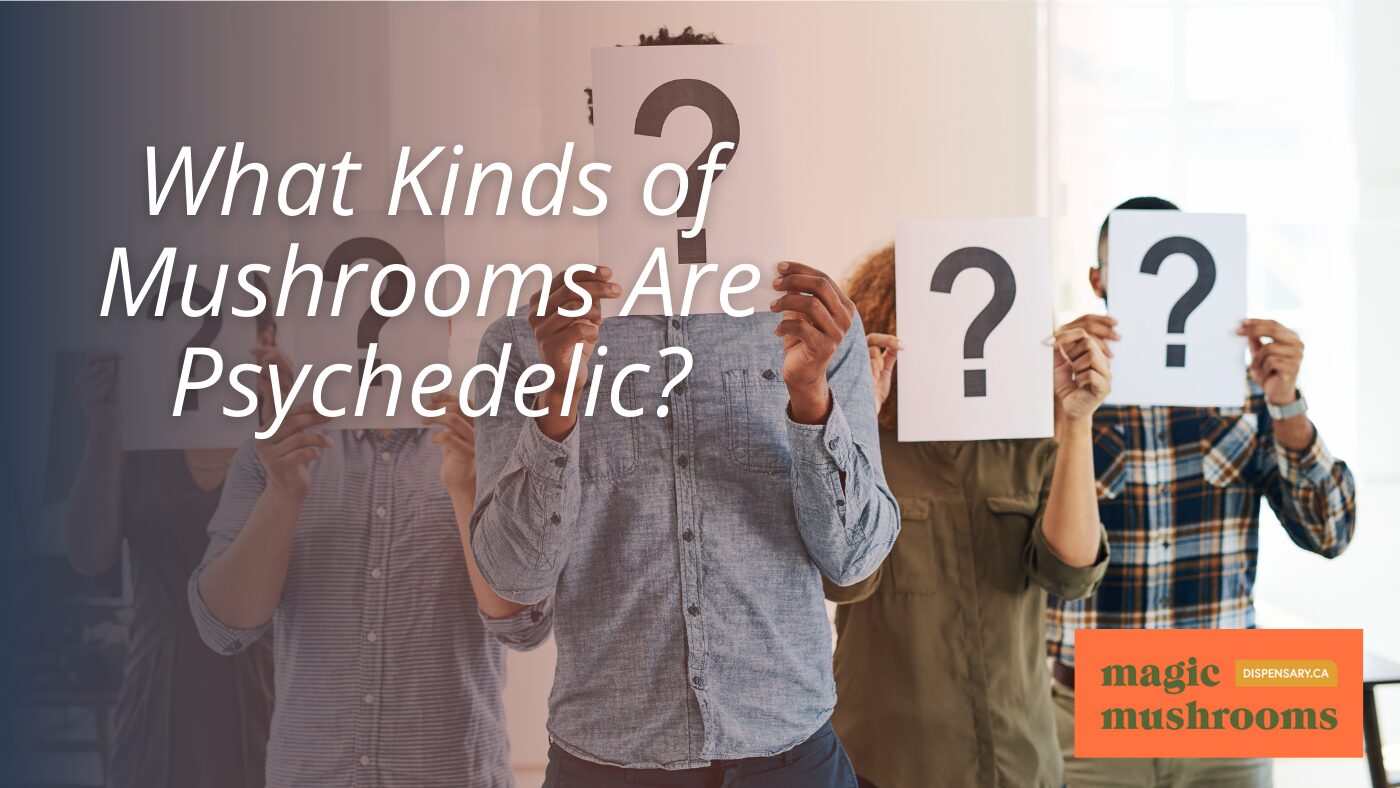
Exploring the psychedelic domain of fungi, it should be emphasized that mushrooms from the Psilocybe, Panaeolus, and Gymnopilus species contain psychoactive compounds such as psilocybin and psilocin, known for inducing hallucinations, altering perceptions, and triggering profound spiritual experiences upon ingestion. This is a demonstration of the potent power these organisms wield, invisible to the naked eye yet transformative in their effect.
The Psilocybe species, for instance, flaunts a rich biodiversity, with over 200 recognized species, each varying in their concentration of psychoactive compounds. They are typically characterized by their dark-spored gills and are renowned for their psychoactive properties. The Panaeolus species, on the other hand, are distinguished by their black or dark brown spores and are known to contain the psychoactive compounds psilocybin and psilocin.
The Gymnopilus species, colloquially known as ‘laughing gym’, are a lesser-known but equally intriguing group of fungi. They stand out with their rusty-orange spores and are known to contain psilocybin, although in lower concentrations compared to their Psilocybe counterparts.
Each of these species offers a unique portal into the psychedelic experience, varying in potency and effect. While some may induce gentle, sensory-enhancing effects, others may trigger more intense, reality-altering experiences. The precise impact is contingent upon a multitude of factors, including the specific strain, dose, individual physiology, and psychological state.
The potential therapeutic benefits of these mushrooms are currently a focal point of scientific exploration. Preliminary research and clinical trials suggest promising outcomes in treating psychiatric disorders and conditions, pointing towards a potential pathway towards psychological liberation.
Psychedelics: A Historical Perspective
While psychedelic mushrooms have garnered significant attention in recent years due to their potential therapeutic benefits, their use can be traced back centuries, with various cultures worldwide recognizing and harnessing their hallucinogenic properties. These cultures incorporated the use of these mushrooms into their spiritual and healing rituals, understanding their profound potential. The Aztecs, for instance, referred to these magic mushrooms as ‘teonanacatl,’ which translates to ‘flesh of the gods.’
This reverence towards psychedelic mushrooms continued through the ages, but the 1970s marked a challenging period for their exploration. Legal restrictions stalled psilocybin research, creating a significant gap in our understanding of these fungi. However, the tides are turning once again. Recent studies have rekindled interest in these mushrooms, revealing their potential benefits for treating conditions like anxiety, depression, and post-traumatic stress disorder.
Today, there are over 180 known types of magic mushrooms, with at least 60 species belonging to the Psilocybe genus alone. The variety is staggering, as is the potency and effects of different species. Each type of mushroom offers a unique psychedelic experience, varying in intensity and duration. As we journey further into the exploration of these remarkable fungi, it’s important to remember their historical significance. They’re not just a modern discovery or trendy therapeutic option but a respected element of our global cultural heritage with untapped potential waiting to be liberated. This understanding lends a deeper appreciation for their place in the world of psychedelics and encourages a responsible approach to their use and study.
The Magic of Psilocybin
In the heart of these historical and culturally significant fungi lies a potent compound called psilocybin, the principal element responsible for their psychedelic effects. A compound naturally produced by more than 180 species of mushrooms, psilocybin is renowned for its ability to induce profound, life-altering experiences.
Psilocybin’s effects are multifaceted, inducing shifts in perception, mood, thought, and self-awareness, often resulting in a sense of unity and interconnectedness with the world around one’s self. However, the intensity and nature of these experiences can vary greatly, influenced not only by the specific mushroom strain and its psilocybin content but also by the individual’s mindset and environment.
Historically, various cultures worldwide have revered these special fungi for their mind-expanding abilities, utilizing them in spiritual and healing practices. Today, despite past legal restrictions, modern science is beginning to uncover the potential therapeutic benefits of psilocybin.
Emerging research suggests that psilocybin may hold promise in treating a range of mental health conditions, including depression, anxiety, and post-traumatic stress disorder. Moreover, its potential in end-of-life care and addiction therapy is also being explored. As we deepen our understanding of this powerful compound, we move closer to liberating its full potential – not only as a tool for personal exploration and growth but also as a valuable asset in our collective quest for mental health and wellbeing.
Psilocybe Cubensis: The Golden Teacher
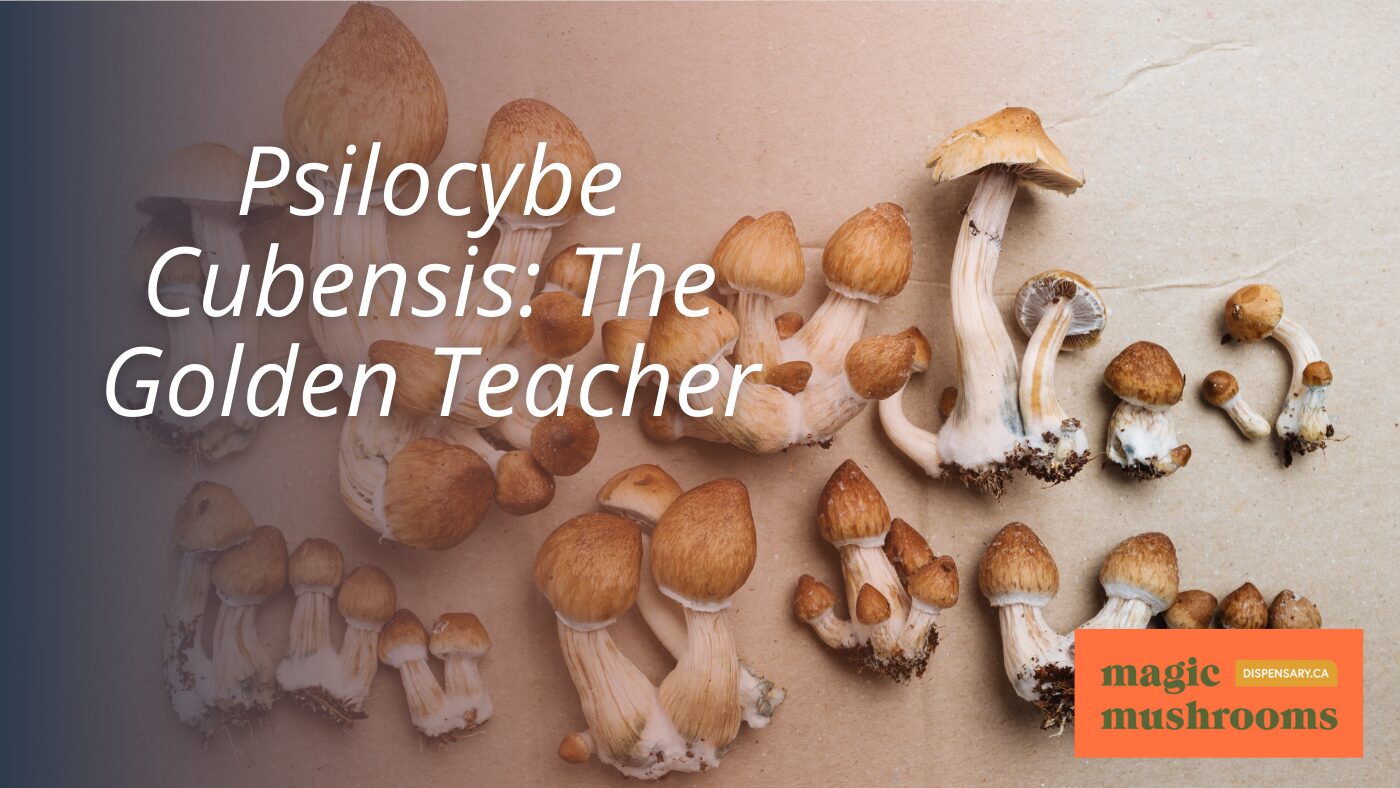
Diving deep into the world of psychedelic fungi, one encounters Psilocybe Cubensis, or the Golden Teacher, a highly potent and popular species revered for its unique mind-altering experiences. Psilocybe Cubensis is widely recognized within the psychonaut community for its golden-colored caps, hence the name Golden Teacher. However, its teaching abilities extend far beyond its visual attributes.
The Golden Teacher is known for being a reliable guide in the exploration of new psychological territories, often resulting in profound insights and personal revelations. This mushroom species contains the psychoactive compounds psilocybin and psilocin, which induce a state of heightened sensory perception, accompanied by a sense of spiritual depth and connectivity.
The Golden Teacher is one of the most widely cultivated magic mushrooms, a confirmation of its potency and its ease of growth. It thrives in a variety of climates and conditions, making it accessible for personal cultivation. This accessibility, coupled with its powerful effects, has made it a popular choice for those seeking to undertake a journey of self-discovery and spiritual enlightenment.
However, it’s crucial to approach the Golden Teacher with respect and caution. The journey it facilitates is deep and transformative, which can be overwhelming for those not adequately prepared. It is recommended that those new to the Golden Teacher, or any psychedelic experience, seek guidance from experienced practitioners to ensure a safe and beneficial journey.
Psilocybe Semilanceata: Liberty Caps
Moving forward in our exploration of psychedelic fungi, we now turn our attention to Psilocybe Semilanceata, more commonly known as Liberty Caps. This particular species of mushroom is widely recognized within the psychedelic community for its potent psychoactive properties, which are primarily attributed to its content of psilocybin and psilocin.
Liberty Caps are one of the most globally widespread psilocybin mushrooms, demonstrating an impressive resilience and adaptability. These mushrooms are typically found in grassy and mossy areas, especially during the autumn months when conditions are damp and cool. They have a distinct conical or bell-shaped cap that has given them their well-known nickname.
The psychoactive compounds contained within Liberty Caps, psilocybin and psilocin, are known to induce a range of effects. These can include enhanced sensory perception, introspective experiences, and euphoria. It is important, however, to note that the strength and nature of these effects can vary widely depending on a multitude of factors, such as the individual’s body chemistry, the mushroom’s potency, and the dosage consumed.
Liberty Caps hold an esteemed place within the pantheon of psychedelic fungi, valued not only for their widespread availability but also for their potent psychoactive effects. This mushroom offers a unique pathway towards liberation of the mind, opening up the gates to a profound exploration of consciousness.
Psilocybe Cyanescens: Wavy Caps
Turning our focus to another remarkable species, we introduce Psilocybe cyanescens, or Wavy Caps, renowned for their potent psychedelic properties and distinctive cap shape. These mushrooms are a sight to behold, with their caramel to chestnut-brown caps undulating like the waves of an ocean, creating an artistic amalgamation of nature and mysticism.
Found most commonly in the Pacific Northwest region of the United States, Psilocybe cyanescens thrives in deciduous woodlands and is often discovered on wood chips, making it a frequent denizen of mulched plant beds in urban areas. Its habitat preference is one of many unique aspects that set the Wavy Caps apart from other species in the Psilocybe genus.
The Wavy Caps’ potency is not to be underestimated. They contain high levels of psilocybin and psilocin – the psychoactive compounds responsible for eliciting profound hallucinogenic experiences. This species is sought after by experienced psychedelic enthusiasts due to its powerful effects, which are often described as intense, transformative, and introspective.
With careful handling, respect for its potential, and knowledge of its effects, Psilocybe cyanescens can be a tool for exploring the depths of consciousness and the landscape of the mind. Its potency and availability make it a significant player in the ongoing discourse on the therapeutic application of psychedelic substances. However, it is essential to remember that legality varies across regions and that responsible use is paramount in the safe exploration of these potent natural wonders.
In the world of psychedelic mushrooms, Psilocybe cyanescens stands out as a powerful, aesthetically pleasing species worthy of attention and respect.
Psilocybe Azurescens: Flying Saucers
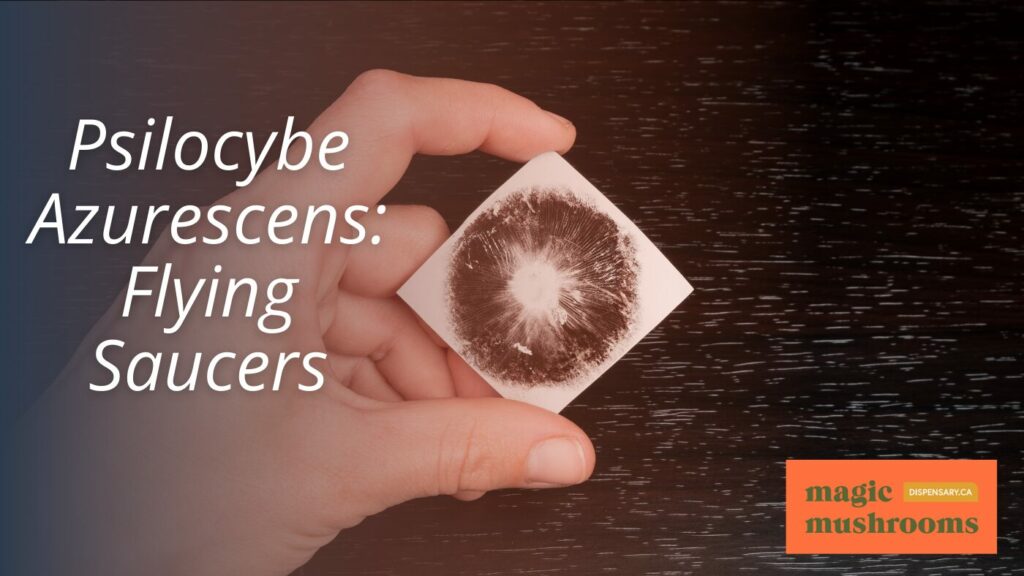
Shifting our attention to Psilocybe Azurescens, colloquially known as ‘Flying Saucers’, we encounter a mushroom species renowned for its extraordinary potency and unique physiological characteristics. This species is indigenous to the Pacific Northwest region of the United States, flourishing in sandy soils rich in lignin and other organic materials.
Psilocybe Azurescens stands out among psychedelic mushrooms due to its exceedingly high levels of psilocybin and psilocin, the psychoactive compounds responsible for inducing mind-altering experiences. Therefore, it holds a prominent position within the domain of psychedelic exploration and research. A distinctive feature of these ‘Flying Saucers’ is their bluing reaction when bruised or damaged, an indication of their high psilocybin content.
Consumption of Psilocybe Azurescens is associated with intense visual and auditory hallucinations, often described as mystical or spiritual experiences. These characteristics have drawn the attention of researchers investigating the therapeutic potential of psychedelic substances. However, the intensity of the experiences also necessitates caution and respect for these natural wonders.
The high potency of Psilocybe Azurescens underscores the importance of dosing responsibly and understanding the potential effects, as the experiences they induce can be profoundly transformative. For those seeking liberation from conventional consciousness, these ‘Flying Saucers’ offer a potent vehicle for exploration. However, due to their potency, they must be approached with respect, understanding, and careful preparation. The journey they offer is not for the unprepared or the faint of heart, but for those who approach them with the right intent, they can provide a deeply rewarding experience.
Psilocybe Mexicana: The Flesh of Gods
From the high potency ‘Flying Saucers’ of the Pacific Northwest, we journey to the spiritual heartland of Mexico to explore Psilocybe Mexicana, a mushroom species revered as ‘The Flesh of Gods.’ This mushroom, steeped in mysticism and tradition, has played an integral role in the spiritual and healing rituals of indigenous Mexican cultures for centuries.
Psilocybe Mexicana is one of the ancient species of psychedelic mushrooms known to man. It is imbued with a potent chemical cocktail, the most significant component being psilocybin. The psilocybin in Psilocybe Mexicana is responsible for its remarkable psychedelic properties. This compound, when consumed, triggers profound alterations in perception, leading to visual and auditory hallucinations.
The effects of Psilocybe Mexicana are more than mere sensory distortions. These mushrooms can forge a profound sense of connectivity with the natural world, a feeling often described as mystical or spiritual. This connection, this sense of unity, is what has made Psilocybe Mexicana a crucial tool in traditional healing and spiritual practices.
However, it is essential to approach this ‘Flesh of Gods’ with respect and understanding. The use of Psilocybe Mexicana, like all potent psychedelic substances, requires informed guidance. Unmonitored or irresponsible use can lead to adverse psychological effects.
For those who seek liberation, who seek to explore the depths of their consciousness and connect with the world around them in a profound way, Psilocybe Mexicana offers a gateway. This mushroom, as ancient as the cultures that revered it, holds the promise of an enlightening journey into the self and beyond.
Psilocybe Tampanensis: Magic Truffles
Delving into the fascinating world of underground fungi, we encounter Psilocybe tampanensis, a unique species popularly known as magic truffles, renowned for their psychedelic properties. This intriguing species stands out for producing sclerotia, hard, compact masses of mycelium that serve as nutrient storage organs. These structures, colloquially referred to as truffles, can survive harsh environmental conditions, thereby ensuring the survival of the organism.
These truffles are home to psilocybin, a naturally occurring psychoactive compound that offers a journey into the depths of consciousness, sparking profound self-reflection and a sense of interconnectedness. Much like their above-ground counterparts, magic mushrooms, these truffles induce auditory and visual hallucinations, creating an altered state of perception that many users describe as spiritually transformative.
The legal status of Psilocybe tampanensis varies widely globally. In some countries where the cultivation and possession of magic mushrooms are heavily regulated, the law does not specifically address magic truffles, rendering them a legal alternative for those seeking liberation through psychedelic exploration.
However, it is critical to approach the consumption of these truffles with respect and caution, acknowledging their potent psychoactive properties. This is particularly important for individuals with underlying mental health conditions, as the intense psychological effects can be overwhelming and potentially harmful.
In essence, Psilocybe tampanensis represents a fascinating facet of the psychedelic fungi world, offering a glimpse into the diverse ways nature has evolved to create these mind-altering compounds. Their unique biology, combined with their potent psychedelic properties, make them an important subject in the exploration of the therapeutic potential of psychedelics.
Psilocybe Atlantis: Forgotten Fruits
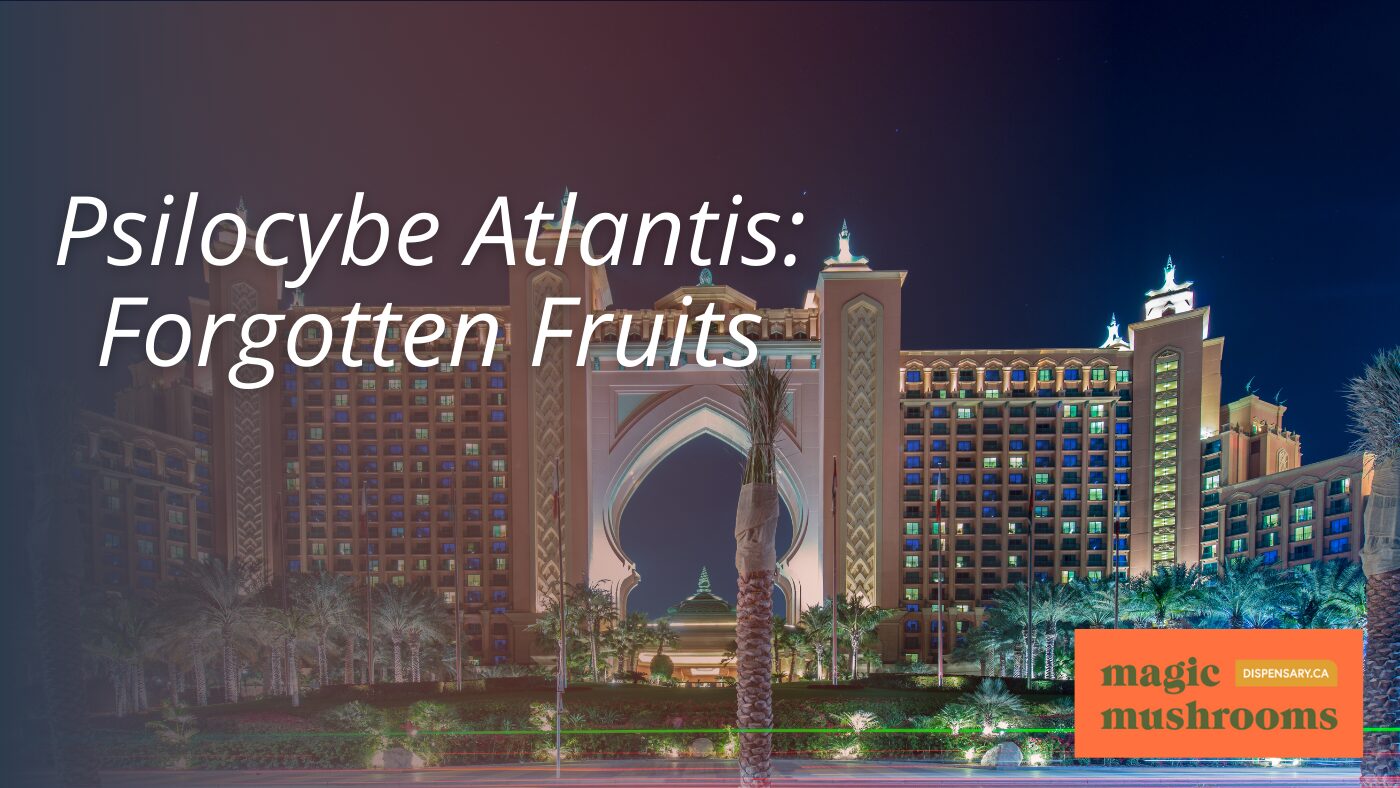
Despite being lesser-known, Psilocybe Atlantis, a rare species of psychedelic mushrooms, presents an intriguing area of study within the domain of psychoactive fungi. This species, often referred to as the ‘Forgotten Fruits’, belongs to the Psilocybe genus, a group renowned for its psychoactive properties.
The primary active compounds present in Psilocybe Atlantis are psilocybin and psilocin, which are responsible for the psychedelic effects typically associated with these types of fungi. The presence of these compounds suggests that Psilocybe Atlantis may offer similar mind-altering experiences as its more recognized relatives, such as Psilocybe cubensis, although this has yet to be definitively confirmed through thorough research.
In terms of geographical distribution, Psilocybe Atlantis is not as widespread. Their rarity and the limited research conducted on them create an air of mystery around this species, which further heightens their appeal to those seeking novel psychoactive experiences.
Being lesser-known does not negate the potential of Psilocybe Atlantis for contributing to the field of psychedelic therapy. In fact, their obscurity could be seen as a call to action for further research to determine their full potential.
Despite the current lack of extensive studies, the existing knowledge about Psilocybe Atlantis’ psychoactive properties suggests that they may hold untapped potential for therapeutic use. As research in this area progresses, it is hoped that the ‘Forgotten Fruits’ will yield insights that can be harnessed for the betterment of mental health treatments, catering to the desires of an audience seeking liberation.
Gymnopilus Purpuratus: Purple Rustgill
Shifting our focus to Gymnopilus purpuratus, also known as Purple Rustgill, it is a remarkable species of psychedelic mushroom within the Gymnopilus genus, characterized by its distinctively purple-colored caps, gills, and spore print. This unique coloring sets it apart from other members of its genus, making it easily recognizable in the wild.
Gymnopilus purpuratus is known for its psychoactive properties, attributed to the presence of psilocybin and other related compounds. These substances are responsible for inducing the psychedelic effects that enthusiasts seek. Such effects include hallucinations, altered perception of time, and heightened sensory experiences, which can lead to profound introspective or spiritual experiences for some individuals.
Although it is revered by proponents of psychedelic therapies, it is important to exercise caution when dealing with Purple Rustgill. Proper identification is paramount, as misidentification can lead to unintended consumption of toxic species. Additionally, the psychoactive compounds it contains can lead to unpredictable reactions in different individuals. Hence, responsible use and respect for the power of these natural substances are of utmost importance.
In terms of geographical distribution, Gymnopilus purpuratus is found in various regions around the world. It primarily grows on decaying wood, making it a saprotrophic species. Its occurrence in nature further emphasizes the diversity and adaptability of psychedelic mushrooms, and their potential to provide us with new insights, both in the world of personal growth and in the field of medicinal research. In this quest for liberation, Purple Rustgill serves as a reminder of nature’s boundless capacity to surprise and enlighten us.
Copelandia Cyanescens: Hawaiian Shrooms
Turning our attention to Copelandia cyanescens, commonly known as ‘Hawaiian shrooms,’ we find a potent psychedelic mushroom species renowned for its small size, dark color, and intense psychoactive effects. Native to tropical regions such as Hawaii and Southeast Asia, these diminutive fungi hold a powerful allure for those seeking liberation through altered perception.
The potency of Hawaiian shrooms is attributed to their high content of psilocybin and psilocin, psychoactive compounds known for evoking profound visual and auditory hallucinations. These substances interact with the brain’s serotonin receptors, leading to a modification of thoughts, mood, and sensory perception. The effects can be deeply transformative, offering glimpses into alternate realities and revealing layers of consciousness often inaccessible in our everyday lives.
Ingesting Copelandia cyanescens is akin to undertaking a profound, introspective journey. Users report a heightened sense of awareness, an amplification of emotions, and a dissolution of ego boundaries. The experience offers not only a brief respite from the conventional world but also a potential pathway towards self-discovery and mental liberation.
Notably, the exploration of these psychedelic properties extends beyond recreational use. The medical and scientific communities are increasingly recognizing the potential therapeutic value of psilocybin-containing mushrooms. Preliminary studies suggest promising applications in the management of psychiatric disorders such as depression and anxiety, indicating that the humble Hawaiian shroom may hold the key to innovative therapeutic interventions.
Panaeolus Cinctulus: Banded Mottlegills
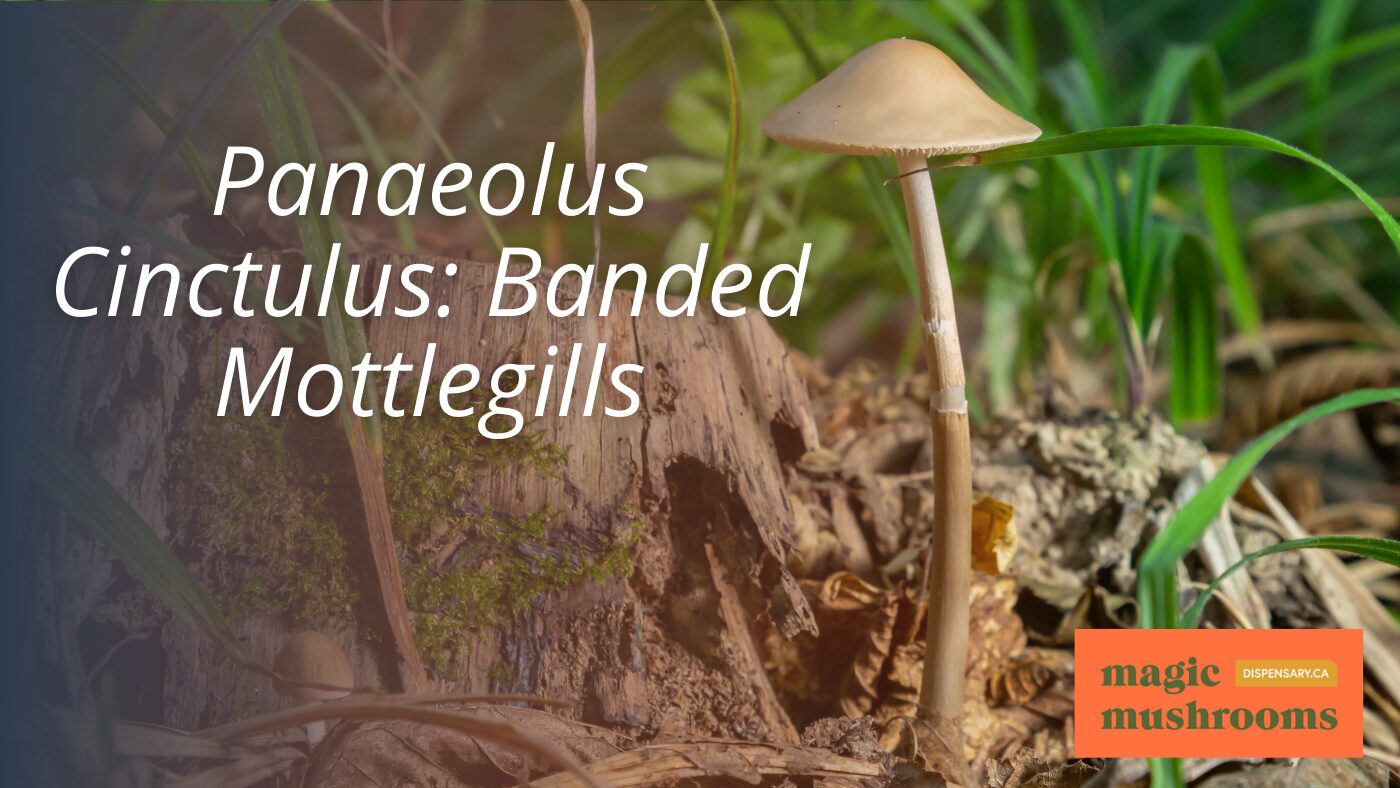
Delving deeper into the fascinating domain of psychedelic mushrooms, we encounter Panaeolus cinctulus, or the banded mottlegills, a unique species known for its potency and distinctive appearance. This species, a member of the Panaeolus genus, is recognized for its inherent psychoactive properties, attributable to the presence of psilocybin and psilocin, compounds known for inducing psychedelic effects.
Panaeolus cinctulus, flourishing in grassy areas, dung, and compost piles, exhibits a wide geographical distribution, making it one of the most accessible psychedelic mushrooms. Its adaptive nature and ability to thrive in various environments demonstrate its robustness and resilience, reflecting the strength and transformative potential it offers to those who seek liberation through its use.
The cap of this mushroom is typically brown, adorned with lighter edges that give it a unique mottled appearance. This distinctive feature aids in its identification, an essential step when foraging for Panaeolus cinctulus. It is important to recognize the significance of proper identification to avoid the consumption of toxic look-alike species, a potential risk that underscores the need for informed and responsible use.
Panaeolus cinctulus, through its potent psychoactive properties and broad availability, presents an intriguing opportunity for exploration and discovery for individuals seeking alternative pathways to self-understanding and liberation. However, it also emphasizes the necessity for a balanced approach, underpinned by education and respect for the power of these extraordinary organisms. As we continue our journey into the domain of psychedelic mushrooms, we come to appreciate the depth and complexity of this remarkable kingdom.
Inocybe Aeruginascens: The Turquoise Inocybe
As we further explore the domain of psychedelic mushrooms, we encounter Inocybe aeruginascens, commonly referred to as the ‘Turquoise Inocybe’, a species recognized for its psychedelic properties and distinctive appearance. This species is a part of the larger Inocybe genus, which is renowned for its diverse array of tryptamine alkaloids that have psychedelic potential. In particular, the Turquoise Inocybe stands out due to its rich composition of psychoactive compounds, such as psilocybin and psilocin. These natural chemicals induce hallucinogenic effects when ingested, making this mushroom a subject of interest for those seeking novel ways of cognitive and emotional exploration.
The Turquoise Inocybe, as the name suggests, is easily identifiable by its distinctive turquoise-colored cap. This physiological trait adds to its allure and mystique, making it a compelling subject within the field of mycology. However, it’s important to approach this species with respect and caution. The psychoactive nature of the Turquoise Inocybe means that indiscriminate consumption can lead to potent and unpredictable effects.
This species serves as a potent reminder of the vast untapped potential that lies within the world of fungi. The Turquoise Inocybe not only represents the rich biodiversity of psychedelic mushrooms but also signifies the potential therapeutic applications of these natural compounds. As the exploration of this domain progresses, the Turquoise Inocybe continues to inspire and intrigue, inviting us to explore deeper into the fascinating world of psychedelic fungi.
Conocybe Kuehneriana: Deadly Conocybe
Exploring further into the domain of psychedelic mushrooms, we encounter Conocybe kuehneriana, often referred to as the ‘Deadly Conocybe’, a species noted for its potent psilocybin content and the associated risks of ingestion. This small, brownish mushroom, found in grassy areas during summer months, emanates a sense of deceptive charm. Its unassuming appearance, however, belies the intense psychoactive experience it can induce, and the potential dangers it poses when consumed.
The ‘Deadly Conocybe’ is a potent carrier of the hallucinogenic compound psilocybin. This chemical compound is the cornerstone of the mushroom’s psychedelic properties. Psilocybin in itself is non-toxic, but its transformation into psilocin in the human body often leads to the hallucinogenic effects that are sought by some individuals. However, due to the potency of this particular species, the effects can be unpredictable, leading to potentially harmful physical and psychological experiences.
Moreover, the ingestion of Conocybe kuehneriana can result in severe poisoning, manifesting in symptoms such as nausea, vomiting, and diarrhea. In severe cases, it can lead to life-threatening situations due to the body’s adverse reaction to the mushroom. Hence, despite the allure of its psychedelic properties, the ‘Deadly Conocybe’ is not recommended for recreational use.
The importance of accurate identification cannot be stressed enough when it comes to psychedelic mushrooms. Conocybe kuehneriana, with its lethal potential, is a stark reminder of the inherent risks that come with the pursuit of mind-altering experiences. The path toward liberation must be tread with knowledge, caution, and respect for the natural world and its powerful constituents.
Pluteus Salicinus: Willow Shield
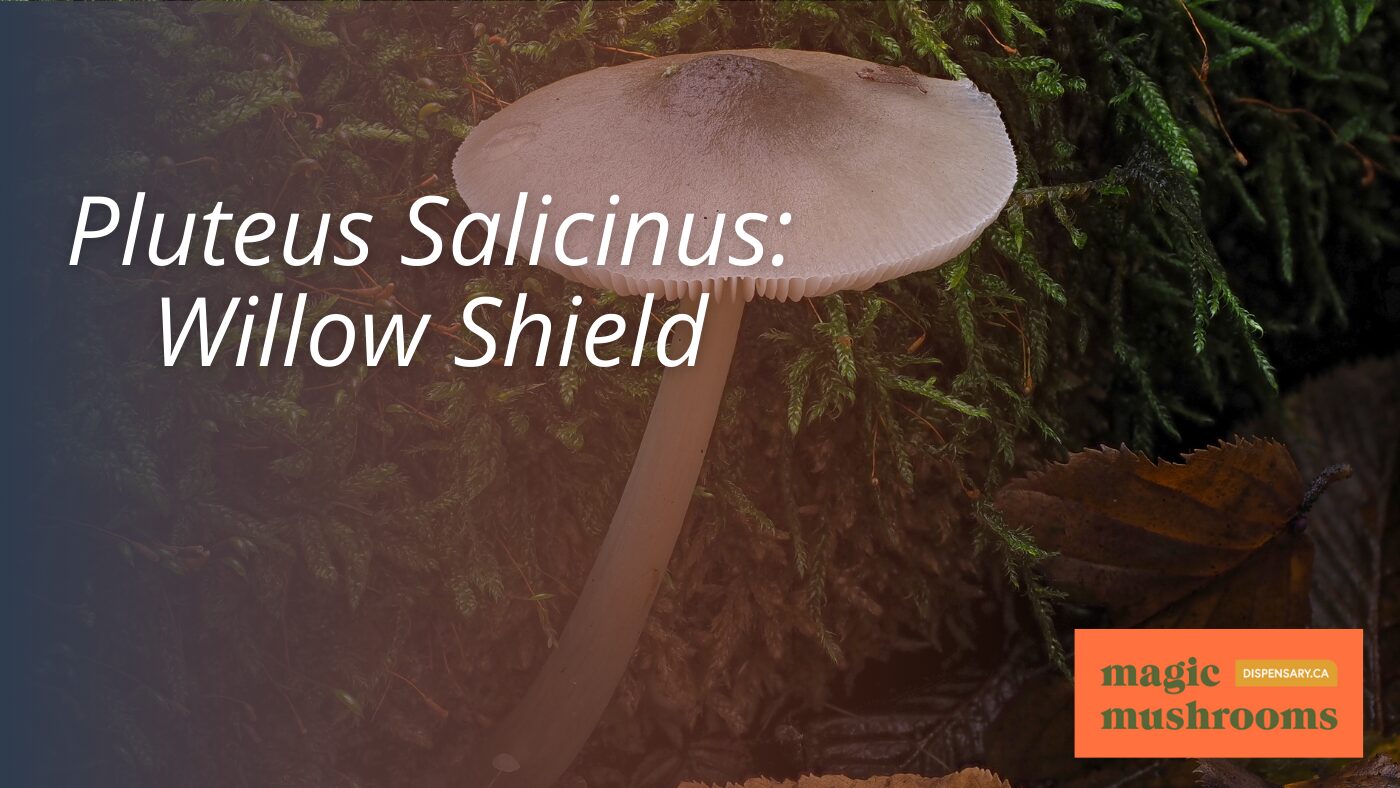
Shifting our focus to Pluteus Salicinus, or the Willow Shield, we encounter another intriguing species of psychedelic mushroom known for its distinctive bell-shaped cap, pinkish hues, and the potent psilocybin and psilocin it contains. This unique fungus, often found growing on decaying hardwood trees, particularly willows, holds a fascinating allure for those on a quest for liberation and exploration of the mind’s uncharted territories.
The chemical compounds psilocybin and psilocin present in the Willow Shield are responsible for its psychoactive properties. These substances, when consumed, are known to induce hallucinations and altered states of consciousness, providing a pathway to transcendental experiences beyond the confines of routine perception.
The Willow Shield’s visual appeal is matched by its intriguing biological profile. The bell-shaped cap, often featuring a striking blend of pink and white tones, sets this mushroom apart, making it easily recognizable to the initiated. The Willow Shield’s affinity for hardwood, particularly willows, contributes not only to its name but also its ecological role as a saprophytic organism, aiding in the decomposition of dead wood.
In the domain of therapeutic exploration and medicinal research, the Willow Shield possesses potential significance. The psilocybin and psilocin it contains hold promise in the treatment of various psychiatric disorders, an area of research that is rapidly gaining scientific attention and validation.
The Legality of Psychedelic Mushrooms
Exploring the intricate legal landscape of psychedelic mushrooms, it becomes apparent that the rules and regulations governing their use, possession, and distribution vary greatly across different geographical jurisdictions. In the United States, for example, psychedelic mushrooms are classified as Schedule I substances under the Controlled Substances Act, making their possession, cultivation, and distribution illegal. This classification signifies that they are considered to have a high potential for abuse and no accepted medical use, despite emerging research suggesting potential therapeutic applications for mental health conditions.
In stark contrast, countries such as the Netherlands and Jamaica have adopted a more significant stance. In the Netherlands, while fresh magic mushrooms are illegal, ‘magic truffles’, which contain the same psychoactive substances, are legal to buy and consume. Jamaica, on the other hand, has no specific laws against psilocybin mushrooms, making it a popular destination for those seeking legal psychedelic experiences.
However, these examples do not signify a global trend towards liberalization. In many parts of the world, the possession, cultivation, and distribution of psychedelic mushrooms remain tightly controlled and severely penalized. Therefore, it is essential to understand the specific laws and regulations in your jurisdiction before engaging with these substances.
The legal status of psychedelic mushrooms is a complex and evolving issue, with regulations continually shifting in response to scientific research, societal attitudes, and political climate. Advocates for the liberation of psychedelic substances maintain the importance of informed, responsible use and continue to call for policy reform that reflects the potential therapeutic benefits of these organisms.
Psychedelic Mushrooms and Indigenous Cultures
While the legal landscape surrounding psychedelic mushrooms is complex and ever-changing, it’s important to acknowledge the rich history these fungi have in indigenous cultures worldwide, serving spiritual and healing roles for thousands of years. The use of these mind-altering mushrooms dates back to prehistoric times, with evidence of their use found in cave paintings and early human artifacts.
The Aztecs, a Mesoamerican civilization, revered these mushrooms as ‘teonanácatl’ or the ‘flesh of the gods’, incorporating them into their religious ceremonies for their ability to induce visions and spiritual awakenings. Similarly, the Mazatec people of Oaxaca, Mexico, utilized these mushrooms in their healing rituals, a tradition which continues to this day. The famed Mazatec healer, Maria Sabina, unintentionally brought these practices to the attention of the Western world during a ritualistic mushroom ceremony attended by R. Gordon Wasson, an American mycologist, in the 1950s.
However, the 1970s saw a clampdown on psychedelic substances, including mushrooms. This led to a significant reduction in research into their potential benefits, effectively stalling progress for several decades. Despite the legal restrictions, indigenous cultures continued to use these mushrooms, respecting their ancestral traditions and the mushrooms’ potential for healing and spiritual growth.
Today, there is a resurgence of interest in these fungi, as research and anecdotal reports suggest potential mental health benefits. As we continue to explore the potential of these mushrooms, it is crucial to acknowledge and respect their historical and cultural significance, as well as the wisdom of the indigenous cultures that have long understood their power.
The Potential Therapeutic Uses of Psychedelics
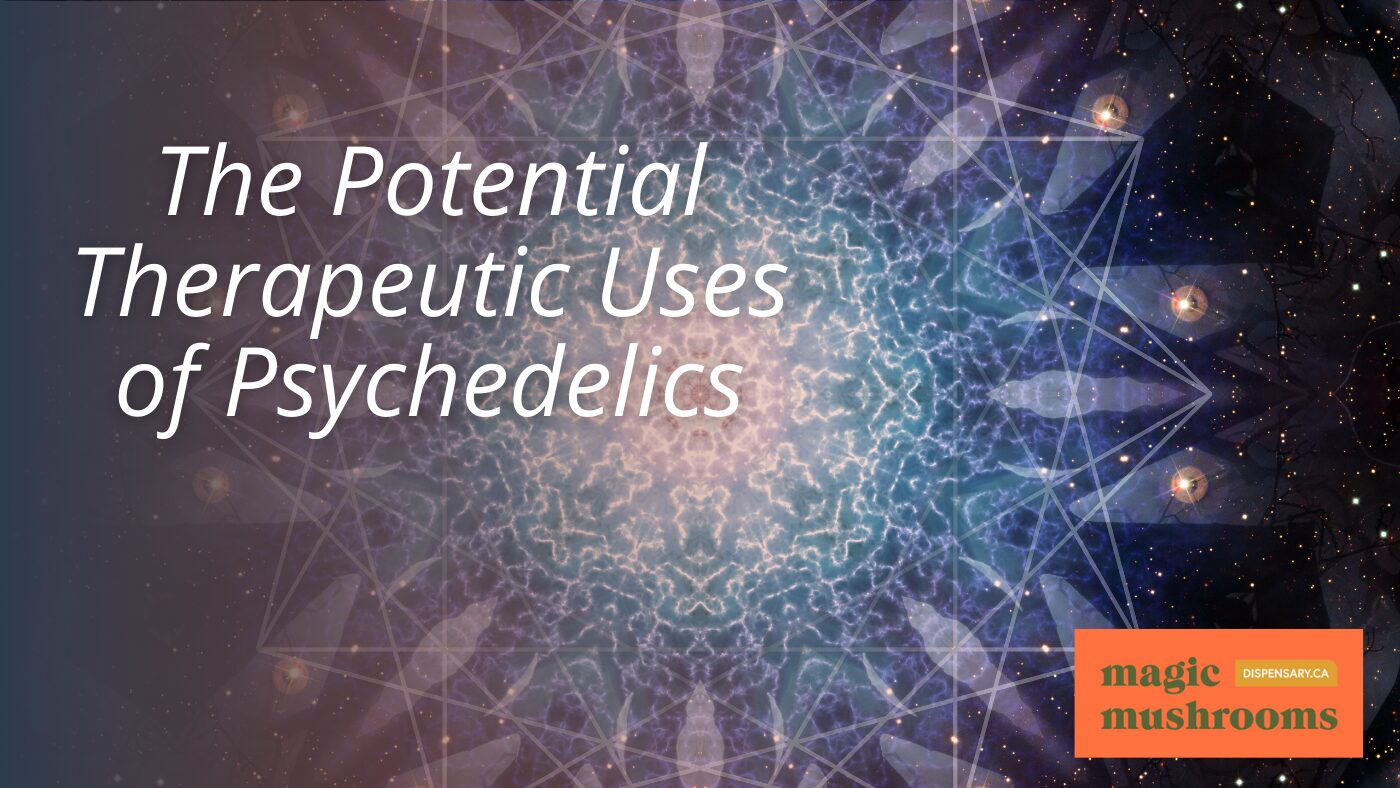
The therapeutic potential of psychedelic mushrooms, particularly those belonging to Psilocybe and Panaeolus genera, is currently attracting significant attention in the field of medicinal research. These fungi contain psychoactive compounds such as psilocybin and psilocin, which are known to cross the blood-brain barrier, inducing hallucinations and potentially beneficial changes in the brain.
Initial results from studies suggest that psilocybin, the primary active compound in these mushrooms, may hold promise in the treatment of various psychiatric disorders and medical conditions. These include depression, anxiety, post-traumatic stress disorder (PTSD), and even certain forms of addiction. The prospect of harnessing these naturally occurring substances to alleviate human suffering is an exciting development in the field of psychedelic therapeutics.
Moreover, it’s not just academia that’s intrigued. The pharmaceutical industry is also showing interest, with a growing number of companies investing resources into studying the therapeutic potential of psilocybin analogues. This rising trend speaks to the growing recognition of the possible medicinal applications of these substances.
Yet, it’s crucial to note that while the potential benefits are encouraging, they do not negate the need for rigorous scientific validation. The hallucinogenic properties of these mushrooms make them a double-edged sword, requiring careful management in a therapeutic context. The goal is not to promote recreational use but to explore controlled, measured application in a clinical setting.
The Risks and Safety Measures
Despite the potential therapeutic benefits, the consumption of psychedelic mushrooms involves certain risks, and careful safety measures must be implemented to minimize potential adverse effects. The psychoactive compounds found within these fungi, namely psilocybin and psilocin, are potent agents capable of inducing intense hallucinations and altered states of reality. These experiences, although enlightening for some, can lead to severe psychological distress, particularly in individuals predisposed to mental health disorders.
To mitigate the potential risks, several safety measures should be observed. Firstly, it is advisable to start with a low dose to gauge individual sensitivity to the psychotropic effects. A trusted trip-sitter, someone who remains sober to monitor and assist during the psychedelic experience, should ideally be present to ensure safety and provide support. Consumption should be conducted in a comfortable and safe environment, free from external stressors that may influence the experience negatively.
It is also paramount to note that the effects of psychedelic mushrooms can last between 4 to 8 hours, with the intensity and duration varying based on the dosage and individual’s sensitivity. These powerful experiences require ample time for processing, and rushing through them could lead to unnecessary distress.
Identifying Psychedelic Mushrooms
Exploring the complex world of psychedelic mushrooms requires a deep understanding of their distinctive features, ranging from cap color and stem characteristics to spore print color and habitat. These characteristics are pivotal in distinguishing psychedelic species from potentially harmful look-alikes. Knowledge is power, and in this situation, it can guarantee a safe and enlightening journey towards liberation.
Psychedelic mushrooms span various genera like Psilocybe, Panaeolus, Gymnopilus, and Inocybe, each with unique identifying traits. Psilocybe species, for instance, are renowned for their dark spore prints and caps that can vary from conical to flat, often bruising blue when handled. They contain the psychoactive compounds psilocybin and psilocin, which induce the sought-after psychedelic effects.
In contrast, Panaeolus species exhibit a different set of characteristics. They typically have dark grey or black spore prints, and their caps are usually smooth and dome-shaped. Though less famous than Psilocybe, they also contain psychoactive compounds, albeit in varying concentrations.
Gymnopilus and Inocybe, on the other hand, are less known in the psychedelic community. Gymnopilus species are easily recognizable by their bright orange or rusty brown caps, while Inocybe species often display a dull brown or tan hue with a distinctive fibrous cap.
The Psychedelic Experience: What to Expect
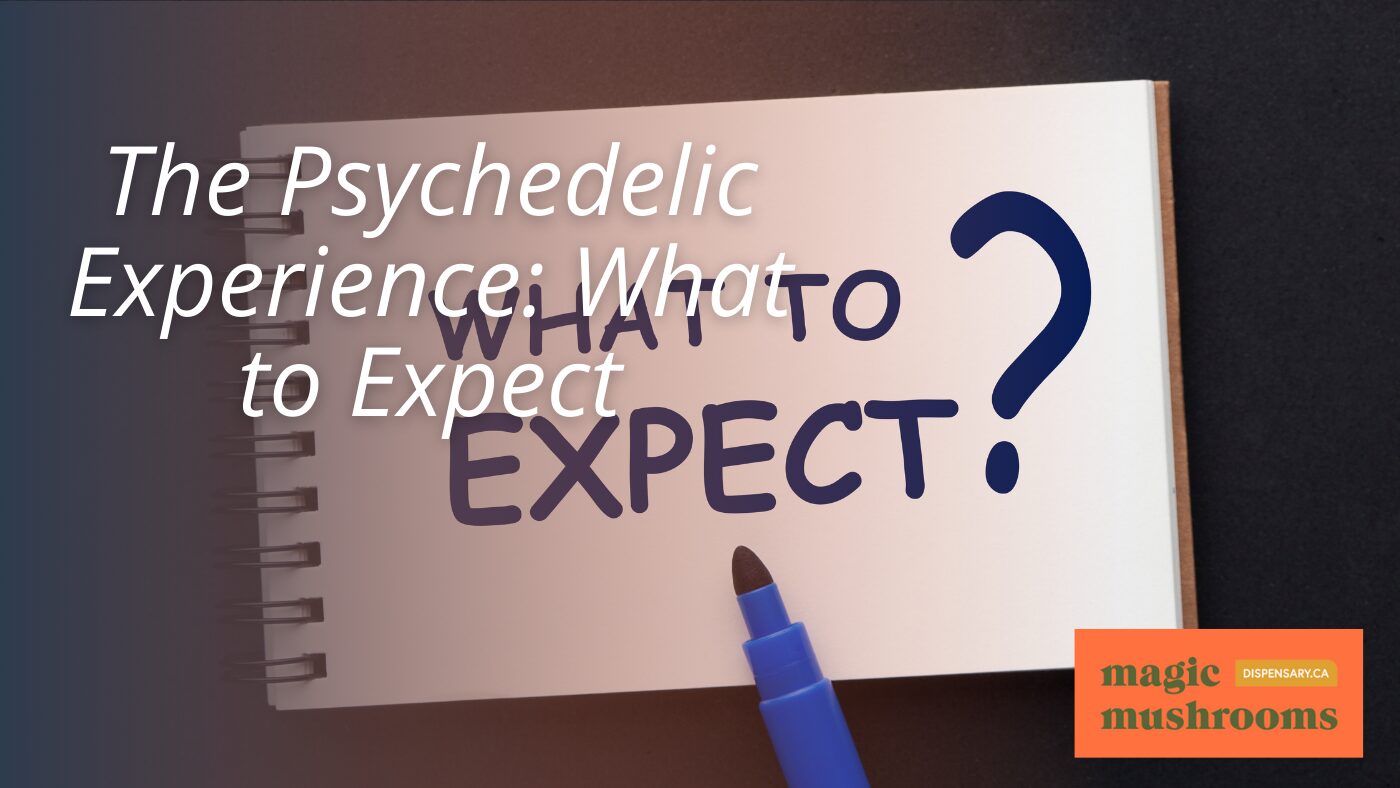
After acquainting ourselves with the distinctive features of various psychedelic mushrooms, it becomes equally important to understand the experiential aspects associated with their consumption. Ingesting these fungi can induce a unique psychedelic experience characterized by visual and auditory hallucinations, shifts in perception, an altered sense of time, and spiritual revelations.
The potency and duration of these effects are contingent on several variables, including the dosage consumed, individual tolerance, and the physical and emotional environment—often referred to as ‘set and setting’. Rigorous scientific research has further confirmed these variables’ influence on the psychedelic experience, underscoring the need for careful consideration and preparation.
One of the most profound psychological impacts reported is the dissolution of the ego, a phenomenon where individuals lose their sense of self and experience a deep sense of oneness with the universe. This sensation often accompanies profound insights that can be life-altering in their depth and transformative power.
However, the psychedelic journey is not without its risks. Safety precautions are essential and can have a significant impact on the nature of the experience. These precautions may include having a sober trip-sitter, researching the specific mushroom species, starting with a low dose, and ensuring a comfortable and safe environment.
The psychedelic experience, while deeply personal and subjective, is a journey of liberation that can offer profound insights into the self and the universe. Therefore, understanding and preparing for this journey is just as important as understanding the mushrooms themselves.
Psychedelic Mushrooms in Modern Culture
In the tapestry of modern culture, psychedelic mushrooms have been woven into various practices, rituals, and research, reflecting their rich history and potential therapeutic benefits. These fungi, specifically those containing psilocybin, have roots in cultural use dating back centuries. Today, their impact extends beyond traditional medicinal usage, permeating the spheres of education, wellness, and entertainment.
The genus Psilocybe, with over 60 species known for their potent psychedelic effects, has particularly drawn attention. The consumption of these ‘magic mushrooms’ varies widely, from standard doses to microdosing, and ingestion via tea, chocolates, or gummies, illustrating their versatility and the innovative approaches towards their use.
However, it’s essential to note the legal restrictions imposed in the 1970s that hindered psilocybin research. These limitations, although lessening in recent times, have left gaps in our understanding of these mushrooms. Yet, burgeoning studies indicate potential benefits for treating various conditions, further emphasizing the need for ongoing exploration.
The effects of psychedelic mushrooms are as diverse as their uses, ranging from visual and auditory hallucinations to ego dissolution and enhanced empathy. These experiences are influenced by ‘set and setting’, encompassing the individual’s mindset and the physical and social environment during consumption.
Psychedelic mushrooms continue to play a pivotal role in modern culture, heralding a path towards wider acceptance and understanding of their benefits. As we unravel the complexities of these fascinating organisms, we move closer to harnessing their full potential, contributing to the liberation of minds and spirits.
The Future of Psychedelic Research
As we move forward, the future of psychedelic research appears promising, particularly focusing on the therapeutic potentials of fungi like Psilocybe and Panaeolus species. The integration of psychedelic fungi into therapeutic practices is not a new concept, but a revival of ancient, indigenous wisdom backed by modern science. The potential for treating psychiatric disorders and medical conditions with these fungi is becoming increasingly recognized within the medical community.
Pharmaceutical companies are investing resources into studying the medicinal properties of these psychedelic fungi. The industry’s interest is primarily piqued by the compounds psilocybin and psilocin, which are known to induce hallucinations and bring about beneficial brain changes by crossing the blood-brain barrier. This exploration of psilocybin analogues and other psychedelic fungi is a key focus in current research.
The biodiversity, geographical distribution, and psychedelic potential of various Panaeolus species are being compiled to provide a foundational dataset. This information is essential for regulatory purposes, aiding in the establishment of guidelines and procedures for the safe and effective use of these substances in clinical settings.
The future of psychedelic research is not just about identifying new species of fungi or discovering new psychoactive compounds. It’s also about understanding the mechanisms of these substances, how they interact with our brains, and how they can be harnessed to promote mental health and personal growth. As the veil lifts on the world of psychedelic mushrooms, we are on the brink of a new era in which these humble fungi may play a significant role in our collective wellbeing.
Responsible Use of Psychedelic Mushrooms
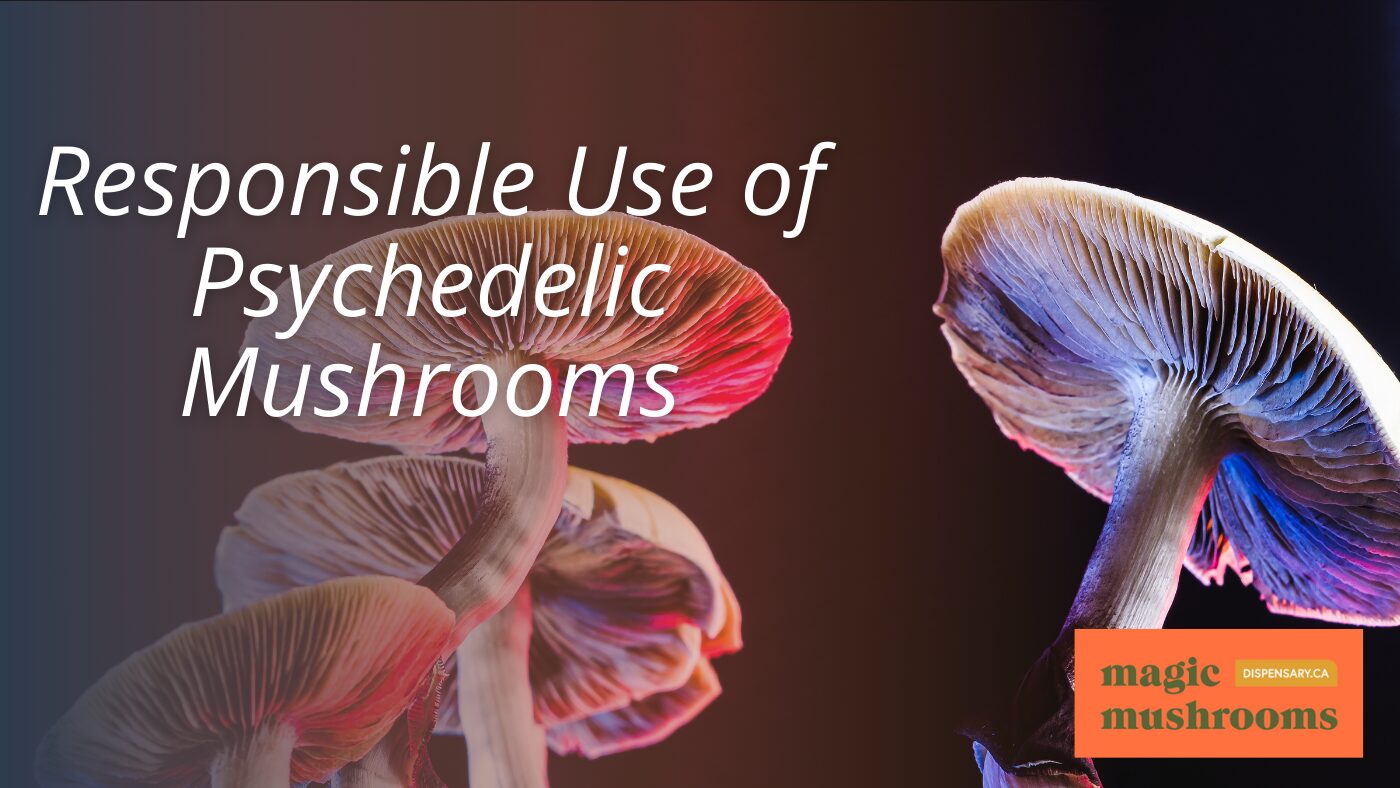
Exploring the domain of psychedelic mushrooms responsibly demands a thorough understanding of their effects, dosage, and associated risks. The effects of these mushrooms can vary greatly depending on the specific species, the consumed dosage, the user’s psychological state, and the environment in which they are consumed. An important facet of responsible use is the knowledge of the correct dosages. Overconsumption can lead to uncomfortable or even dangerous experiences, hence it’s essential to start with small doses and gradually escalate.
The setting plays a crucial role in shaping the psychedelic experience. A safe, comfortable, and controlled environment can help in reducing anxiety and paranoia, enhancing the overall psychedelic journey. Having a trusted trip-sitter or guide present can be advantageous, providing support and ensuring a positive experience.
Identifying the specific species of psychedelic mushrooms to be consumed is crucial. Misidentification can lead to ingestion of potentially harmful species. Hence, research and due diligence are paramount in avoiding adverse effects.
Conclusion
Ironically, the once demonized and feared mushroom psychedelic species are now at the forefront of cutting-edge medical research. Their potential to treat various psychiatric disorders has been identified and recognized, thus shifting their previously stigmatized status. As we continue to explore the uncharted territories of the Panaeolus genus, it is with a newfound respect for these fascinating fungi. This guide serves as a demonstration of the transformative power of nature’s most intriguing creations involving mushroom psychedelic species.
Buying Microdosing Mushrooms Online in Canada
Are you an avid microdoser or looking to venture into the art of microdosing? Working with a reliable, trustworthy shrooms dispensary is paramount in becoming a better version of yourself. Magic Mushroom Dispensary prides itself on its comprehensive collection of top-notch microdosing products, psilocybin books, excellent customer service, and fast, discreet shipping. Visit our online shop today and enjoy low prices and free shipping for orders above $99.
Originally posted on June 29, 2024 @ 7:12 am

